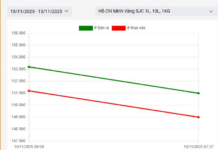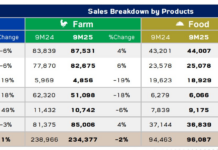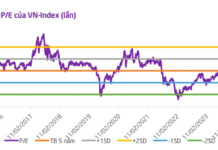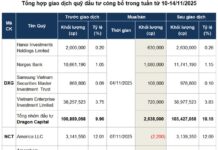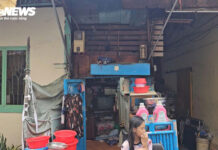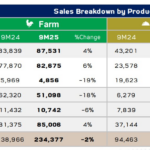
Large plots of land in the outer districts of Hanoi, such as Quoc Oai and Thach That, are being subdivided and resold for land speculation rather than being put to practical use. Photo: A land lot divided into four smaller plots being advertised for sale.
Hanoi is seeking feedback on a draft regulation regarding the conditions for land division and consolidation, as well as the minimum area and dimensions for each type of land. According to the proposal, if a land division does not create a new access route in a ward or town, the resulting plot must have an area of at least 50 square meters, a length of more than 4 meters, and a width facing the road of at least 4 meters.
For plain communes, the minimum area for land division is set at 80 square meters, while for midland communes, it is 100 square meters, and for mountainous communes, it is 150 square meters.
In cases where the land division results in the creation of a new access route, the required width of the cross-section of the route is specified as 3.5 meters for towns, 4 meters or more for plain areas, and 5 meters or more for midland and mountainous regions.
Regarding non-agricultural land, the draft regulation applies to plots that are not subject to state allocation or lease for project implementation. In wards and towns, for commercial and service land, the new plot must have a width facing the road of at least 10 meters and a minimum area of 400 square meters. For other types of non-agricultural land, the plot must have a width of over 20 meters and a minimum area of 1,000 square meters.
In other communes, the minimum area for commercial and service land division is set at 800 square meters, while for other types of non-agricultural land, it is 2,000 square meters.
Currently, land division in Hanoi is governed by Decision No. 20/2017, which stipulates that the post-division plot must have a minimum area of 30 square meters in wards and towns and not less than 50% of the new minimum land allocation limit in other areas.
Issues to Consider
Economist Dinh Trong Thinh believes that increasing the minimum area for land division in wards and towns will create a mechanism to curb rampant land subdivision and lotting, which disrupts urban planning in the city center. Hanoi, as a special municipality, faces significant pressure from an increasing migrant population, resulting in high population density in its districts.
In reality, not only in the inner districts but also in the outer districts of Hanoi, such as Quoc Oai, Thach That, and Ba Vi, there has been a wave of investors buying large plots of rural land and then subdividing and reselling them, driving up prices for profit. This practice has led to the fragmentation of rural areas and disrupted long-term sustainable development and economic stability, as land, a vital means of production for locals, has become a tool for financial speculation rather than being utilized productively.
Observations reveal that these minimally-sized subdivided plots are often left vacant for years without any residential or construction activity after being bought and sold, especially when the market cools down and speculation subsides.
According to experts, this situation is eroding rural planning day by day and could have a long-term impact on the sustainable and stable development of the economy. Lawyer Pham Thanh Tuan from the Hanoi Bar Association commented that the proposed increase in the minimum conditions for land division has only been assessed from a technical perspective (including total area, road frontage, and plot length) without considering other factors such as the origin of the land or the landowner.
For instance, a family with a 90-square-meter plot in a central district wishes to divide it into three smaller plots to give to their three children, each measuring 30 square meters. With the new regulation, the plot does not meet the requirements for division into two, let alone three plots, as per Tuan.
“The regulation on the minimum area for land division should take into account other aspects such as social and economic aspects of the people, in addition to technical criteria,” the expert opined.
Lawyer Pham Thanh Tuan suggested that the current conditions regarding the minimum area for land division (a minimum of 30 square meters and a length of 3 meters) should be maintained, and a provision could be added to stipulate that individuals who acquire land through transfer from others can only divide the land after a certain period, such as 3 to 5 years from the date of the transaction. On the other hand, individuals who inherit, receive as a gift, or are allocated or leased land by the State would not be subject to such time restrictions.
Echoing this view, economist Dinh Trong Thinh emphasized the need to balance the legitimate land division needs of the people with the prevention of abuse, irregularities, and disruption of urban planning. Therefore, he proposed that the suggestion to increase the minimum area for land division should be carefully surveyed, especially among residents in the wards and towns across the city.
Previously, in a report submitted to the National Assembly on the results of thematic supervision and questioning in the field of construction, Minister of Construction Nguyen Thanh Nghi also mentioned that the 2023 Law on Real Estate Business was formulated to tighten the regulations on investors’ business of land use rights in real estate projects.
Specifically, the law stipulates that the transfer of land use rights to individuals for self-construction of houses or self-subdivision and sale of land plots is prohibited in the wards of special, type I, II, and III cities. This regulation will apply to 105 cities and towns, an increase of 81 localities compared to the current regulations. For the remaining areas, the People’s Committees of the provinces will decide on the areas where investors can subdivide and transfer land use rights to individuals for self-construction of houses.
Meanwhile, the previous law only prohibited the subdivision and sale of land plots in the wards of special and type I cities directly under the Central Government; areas with high requirements for architectural landscape, areas in the center and around the works that are architectural highlights in the city; the frontage of roads at the district level and above, and the main landscape roads in the city.
“The new regulation will create favorable conditions for localities to proactively and effectively control the subdivision and sale of land plots,” said Minister of Construction Nguyen Thanh Nghi.
The New Real Estate ‘Gold Rush’: Strategies to Curb the Frenzy
In recent times, land prices in Hanoi have been surging to unprecedented highs, sparking fears of an asset bubble. This unusual surge in prices has led to concerns about a potential “virtual fever”, with many worried about a possible real estate “bubble”.
“CapitaLand Development Launches ‘Steps of Love’ Campaign in Hanoi”
On August 27, 2024, CapitaLand Development (CLD) proudly launched its second annual “Steps of Love” campaign in Hanoi, in collaboration with the CapitaLand Hope Foundation (CHF) and Blue Dragon Children’s Organization. This initiative aims to unite the community in supporting underprivileged children and youth in Vietnam.








